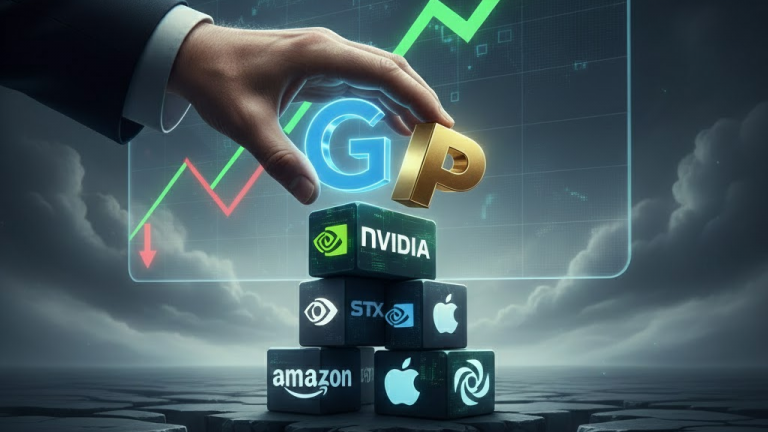Summary (TL;DR)
In a landmark move for the tech industry, AMD and OpenAI have announced a multi-billion dollar strategic partnership that positions AMD as a major competitor to Nvidia in the AI chip market. Under the deal, AMD will supply its high-performance Instinct GPUs to power OpenAI’s next-generation artificial intelligence models. This is a massive win for AMD, providing a huge revenue stream and a crucial endorsement from a leading AI company. The market reacted with strong optimism, causing AMD’s stock to surge over 20%, as the agreement signals a significant potential shift in the balance of power within the critical semiconductor sector.
For investors, the key takeaway from the landmark partnership between AMD and OpenAI is the significant disruption to the AI chip market, long dominated by Nvidia. This multi-billion dollar deal validates AMD’s position as a formidable competitor in the high-stakes AI infrastructure space. The agreement not only secures a massive revenue stream for AMD but also provides OpenAI, a leading AI developer, with a powerful alternative for the vast computing power it needs, potentially reshaping the competitive landscape and supply chain for the entire tech sector.
This development is significant because it directly impacts the valuation and future growth prospects of AMD, creating a more competitive dynamic with market leader Nvidia. For investors, this signals a potential shift in the semiconductor industry’s balance of power and highlights the immense, ongoing capital investment required to advance artificial intelligence, underscoring the sector’s long-term growth trajectory.
The Core News (What Happened?)
On October 6, 2025, Advanced Micro Devices (AMD) and OpenAI announced a definitive multi-year, multi-billion dollar strategic partnership. Under the agreement, AMD will supply OpenAI with its high-performance Instinct GPUs to power the AI leader’s next-generation infrastructure. OpenAI has committed to deploying 6 gigawatts of AMD’s AI chips, with the first phase involving a 1-gigawatt deployment of the upcoming Instinct MI450 GPUs scheduled to begin in the second half of 2026. As part of the deal, AMD has issued warrants to OpenAI, allowing it to acquire up to 160 million shares of AMD stock (approximately 10% of the company), contingent on meeting specific deployment and performance milestones.
Background (Setting the Stage)
Coming into this week, investors and analysts were keenly focused on the intense competition in the AI semiconductor market. Nvidia has been the undisputed leader, with its GPUs being the go-to hardware for training and running complex AI models. While AMD has been making strides with its Instinct line of accelerators, the market was largely awaiting a massive-scale adoption to validate it as a true competitor. Before this announcement, much of the discussion revolved around OpenAI’s immense need for computing power and its reliance on Nvidia. The expectation was that OpenAI would continue to diversify its suppliers, but the sheer scale and deep integration of this partnership with AMD have far exceeded baseline expectations.
The Debate (The Bull vs. Bear Case)

The Bull Case (The Optimistic View): On one hand, optimists believe this could lead to a significant re-rating of AMD’s stock and its long-term potential. Proponents of this view, as reflected in the immediate 25% surge in AMD’s share price, see this as a transformative win. Analysts at Investing.com and Seeking Alpha highlight that the deal is expected to generate “tens of billions of dollars” in revenue for AMD. The validation from a premier AI company like OpenAI effectively rubber-stamps AMD’s technology at the highest level, potentially opening the doors to more large-scale deals with other AI developers and cloud providers. The equity component, where OpenAI becomes a major shareholder, creates a powerful strategic alignment, ensuring a deep, collaborative partnership on future hardware and software development.

The Bear Case (The Cautious View): On the other hand, cautious voices point to the massive financial commitments and the execution risks involved. Commentators on forums like Seeking Alpha have raised questions about OpenAI’s financial stability, noting its high cash-burn rate and massive, simultaneous investments with multiple partners. There are concerns that these large-scale deals resemble the “dot.com bubble,” with enormous capital expenditures that have yet to translate into sustainable profits. Some critics also view the warrant agreement as a form of “vendor financing,” where AMD is essentially helping to fund the purchase of its own chips. Furthermore, Nvidia’s ecosystem, particularly its CUDA software, remains a powerful and sticky advantage, and it will be a significant challenge for AMD’s ROCm software platform to achieve comparable developer adoption.
By the Numbers (Key Data & Metrics)
- AMD Pre-Announcement Stock Price: ~$164.67 (Closing price on the Friday before the announcement)
- AMD Post-Announcement Stock Surge: Over 22-25% in pre-market and early trading on October 6, 2025, exceeding $205 per share.
- Total Compute Power: 6 gigawatts (This is a measure of the total electrical power consumed by the chips, indicating a massive scale of deployment.)
- Initial Deployment: 1 gigawatt using AMD Instinct MI450 GPUs, starting in the second half of 2026.
- Equity Warrants: OpenAI has the right to purchase up to 160 million AMD shares, representing about 10% of the company.
- Projected Revenue for AMD: The deal is expected to generate tens of billions of dollars over its multi-year term.
Disclaimer: This article is for informational purposes only and does not constitute financial, investment, or legal advice. The information provided is a synthesis of publicly available data and expert analysis and should not be considered a recommendation to buy or sell any security. Investing in the stock market involves risk, including the possible loss of principal. Past performance is not indicative of future results. Readers should consult with a qualified financial advisor to determine an investment strategy that is suitable for their own personal financial situation and risk tolerance.





















